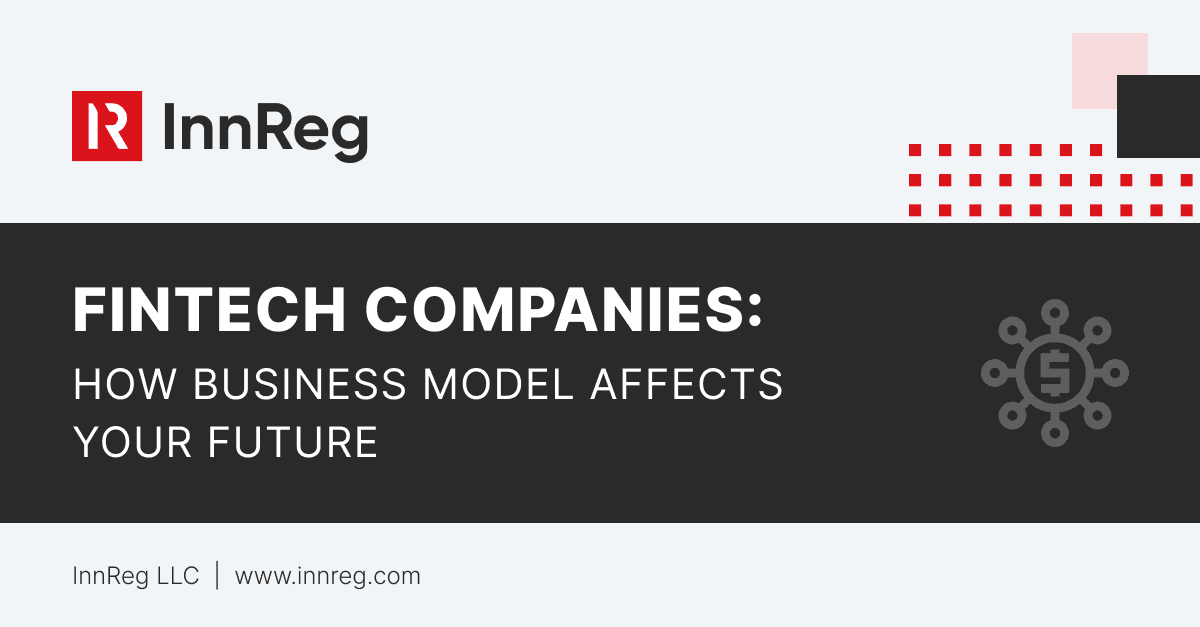
All Fintech
How Business Model of Fintech Companies Affects Their Future
Dec 2, 2023
·
InnReg
·
9 min read
Contents
The business model fintech companies choose can determine their future with a point of no return.
Fintech developers, by nature, are innovators who enjoy disrupting the marketplace with cutting-edge concepts. It may not be part of their personality to embrace the mundane aspects of running a regulated company like a lender or broker-dealer. That’s why many innovators tend to avoid the complexities of the full-stack model without completely evaluating the benefits.
See also:

InnReg is a global regulatory compliance and operations consulting team serving financial services companies since 2013. If you need assistance with compliance or fintech regulations, click here.
Full-Stack Model Vs Partial-Stack Model
It’s vital to your business’s future to consider the strategic business implications of the models early in the development process. This decision will radically shape your business model, product strategy, operational setup, staffing requirements, licensing requirements, etc. It can also have an enormous impact on your profit potential because a full-model organization reaps the rewards of additional revenue streams from loan interest or brokerage commissions.
We're devoting two articles to the subject because it is such a crucial decision for a startup. In Part One, we show you the differences between models and the pros and cons of each option. In Part Two, we will share specific examples of why we know that the full-stack model is the only way to truly disrupt the marketplace.
What’s the Best Option?
If your product is an ingredient in a bigger program, you won’t control the entire end-user experience. Without the regulatory requirements, it’s faster, easier, and less expensive to launch and maintain your product. Yes, the partial model is less complex.
Full model is more complex, and it requires specialized expertise. A traditional bank or a brokerage firm provides an end-to-end experience to the end-user, so they’re required to be a regulated entity. The launch timeline is longer, and the program is more expensive to maintain. However, the revenue potential is much greater than the partial model.
These descriptions simplify the situation, but the reality of models is not so black-and-white. And it’s paramount to understand each option in the context of your own situation to determine the best approach for your new product or service.
What Are Partial Stack Pros and Cons?
With the partial model, you sell or license your ingredient technology to a financial services organization like a traditional bank, online lender, or broker-dealer. Your clients, such as these financial services organizations, interact directly with the consumer. As a full model provider, they are required to be licensed by a government regulatory body like FINRA or the SEC.
It might seem attractive to bypass the regulatory agencies, but it could mean leaving a lot of money on the table. This happens because non-regulated entities aren’t allowed to receive a share of the transaction revenues generated when the consumer uses your client’s products or services. For example, a brokerage firm is not allowed to share commission revenue with an unlicensed entity. Your product might deliver a trading algorithm that differentiates your client’s online broker-dealer in the marketplace, substantially increasing their sales and revenue. However, you won’t capture the total value of your contribution unless you control the customer relationship, which requires a full-stack model with the appropriate regulatory licenses.
Another appealing aspect of the partial model is speed-to-market. However, this may not be true in every situation. One of our clients licensed to a large established bank. Their presumably short launch timeline eventually extended to 18 months after lengthy contract negotiations, a multi-pronged due diligence process, and numerous stakeholder buy-ins across various departments, all on top of the integration. Plus, our client was required to conform to the regulatory requirements of the bank. So, in the end, their timeline and compliance requirements were very similar to the typical process for becoming a regulated entity, minus a huge revenue potential.
What Are Full-Stack Model Pros and Cons?
With this model, you build a complete product or service delivered directly to the consumer without partnering with a regulated entity. In this case, your company will very likely need to become a registered entity with a regulatory agency.
For example, Lenny Credit was promoting a mobile-only lending app that processed loan applications and transfers funds online without a brick-and-mortar bank. Given direct relationships with customers, they were required to become a regulated entity. The benefit to Lenny Credit had that as a result, they controlled the customer experience and captured a larger share of program revenue.
Becoming a Regulated Entity
Many innovators dismiss the full-stack model because they believe the process of becoming a regulated entity will be time-consuming, onerous, and expensive. However, it’s possible to minimize the time and cost to complete this process by leveraging the expertise of an outsourced compliance expert.
Becoming a regulated entity is normally a 3-step process:
First, you’ll need to meet specific requirements established by the regulators (e.g., experienced principals and sufficient working capital). The experienced principals can be in-house employees or outsourced manpower up to and including the Chief Compliance Officer (CCO).
Second, you’ll need specialized legal and compliance expertise. These experts provide intelligence and recommendations, and they also take the lead in meetings with regulators as they communicate your business model, product attributes and compliance strategy.
Third, you’ll need an extended timeline to accommodate the licensing process. You should allow 6 months to become a registered FINRA broker-dealer. You should allow one to two years to gain approval as a licensed financial lender or money transfer agent in all 50 states.
Accelerating the Timeline
An outsourced compliance expert can help you accelerate these timelines. They can’t make the regulators move faster, but they can manage the process in the most efficient way possible.
They’ll work with your project managers to parallel-path the registration process with your product development and operations setup so that you can minimize the impact on your launch timeline.
For example, one of our clients launched their program in a single large US state that contained a large number of their primary prospect audience. Their long-term plan was to roll out in other US states over time.
This rolling launch allowed the company to generate revenues from their largest market, but they needed only one financial lender license in a single state. This process saved them substantial time and energy.
Full-Stack Model Impact on Back Office Operations
Your operations team is an integral part of the early discussion about models because a full-model company will need a more complex operational structure. The company will need to fulfill the fintech regulatory requirements, and they’ll need to build a service organization to support users with transactional support, technology support, and customer service support.
This approach requires additional departments that will incur additional operating expenses, but this approach also provides the incremental revenue benefits that come when you own the customer relationship.
APIS to the Rescue
The costs and timeline for building back-office functionality can be streamlined. There are many companies that provide almost every necessary core functionality via API. As cloud-based solutions, their setup is turnkey, and there’s minimal impact on your existing processes and systems.
There are plenty of good choices when it comes tooutsourcing back-office functionality, including:
loan origination software,
funds transfer,
payments processing,
customer service,
user support,
CIP (customer identification program),
In fact, regulators may be more comfortable knowing you’re leveraging a tested program instead of trying to build your own when you’re still new to the regulatory processes.
Business Model Strategies for Fintech Startups
Business model strategies for fintechs have been changing over time. Banks have collaborated with fintech companies for years as they attempted to bundle traditional and digital services and technologies. Often with mixed results. This mutually beneficial relationship model is changing. According to a recent study published in Business Insider Intelligence (conducted by IDC and SAP), “While a third of global banks continue to view fintechs as collaborators, nearly a quarter now see them as acquisition targets.”
The study goes on to say that an additional 25% of global banks believe they are in competition with fintech developers, “They represent a possible threat. We compete against them.” In other words 50% of all global banks look at fintech and see a threat or an acquisition target.
One former fintech founder who sold his technology to a bank spoke about his new role as a member of their executive team, “I continue to have a leadership role and spend a significant part of my time with regulators, investors, founders, and financial institution executives from around the world.” This is not an unusual story. It makes us wonder if he gave up his best shot at financial services disruption when he decided to sell to a traditional bank, instead of staying fully focused on the next most disruptive product innovation.
There’s another downside to selling your cutting-edge technology to a large, bureaucratic organization. The original vision gets bogged down in corporate committees and the practicalities of a major systems integration. Your forward-thinking concept ends up diluted, unrecognizable, or quietly buried in an attempt to quash competition and protect market share.
Disruption doesn’t happen in a lab. Disruption happens in the marketplace. So we would argue that selling a creative concept to a big bank does not promote innovation. You must be willing to invest in the full stack option in order to protect your product vision and provide your customer with a superior user experience that differentiates your company and disrupts the product landscape.
Becoming a Full Stack Company
Going full-stack is a more complex process than the partial stack, but many times the return on investment will be positive. It’s important to conduct a cost/benefit analysis with long-term revenue projections based on your unique situation. You’ll likely find tangible value from transaction-based revenue streams like interest income and commissions. In addition to the value from customer insights gained from owning the entire user experience.
In Part One of this report, we reviewed the 3-step process for becoming a regulated entity. And we also reviewed tactics for accelerating the timeline.
It helps to work with an outsourced compliance expert if this is new territory for your compliance team. Outsourced consultants can support your team with enhanced capabilities, insights and guidance. Or they can take over the entire process, so your team stays focused on their launch task list.
What’s the Best Compliance Stack for Your Startup?
Are you weighing the pros and cons of a partial vs. a full-stack model for your startup?
Reach out today for a complimentary consultation.
How Can InnReg Help?
InnReg is a global regulatory compliance and operations consulting team serving financial services companies since 2013.
We are especially effective at launching and scaling fintechs with innovative compliance strategies and delivering cost-effective managed services, assisted by proprietary regtech solutions.
If you need help with compliance, reach out to our regulatory experts today:
Published on May 2, 2017
Last updated on Dec 2, 2023
Related Articles

All Fintech
Feb 12, 2025
·
11 min read

All Fintech
Dec 26, 2024
·
18 min read

All Fintech
Dec 11, 2024
·
8 min read
Latest LinkedIn Posts












